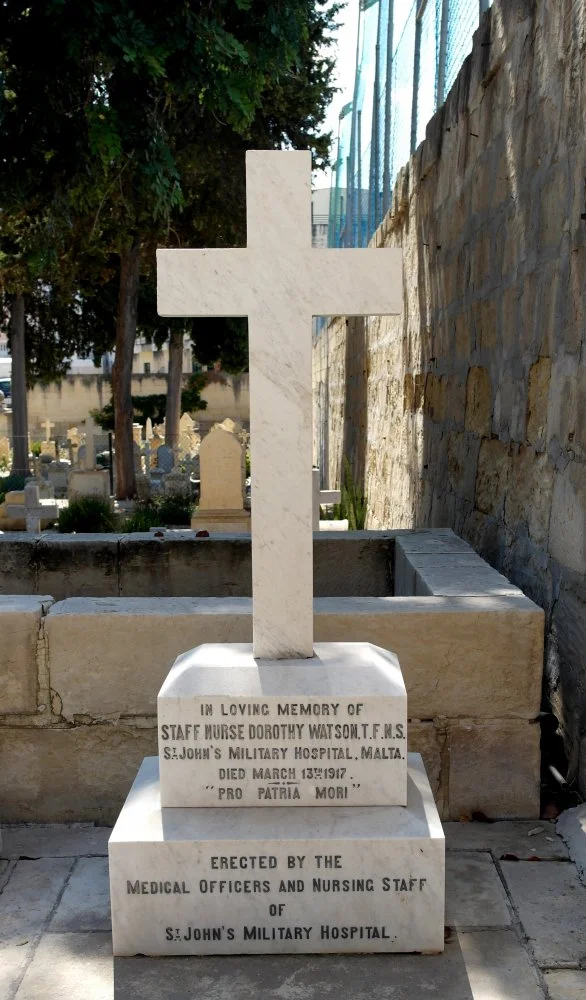WATSON Dorothy Mortimer. Staff Nurse, Territorial Forces Nursing Service, stationed at St. Johns Military Medical Hospital, Malta. She contracted measles and died of toxaemia on the 13th March 1917 aged 27 in the hospital where she worked. Born in 1888 in the registration district of Wharfedale, West Yorkshire, Her name is commemorated on the Harrogate Hospital War Memorial, also on the Memorial in the chapel at the Royal Masonic School for Girls. This memorial was dedicated on the centenary of her death.
http://greatwarnurses.blogspot.co.uk/2015/09/dorothy-mortimer-watson-soldiers-will.html
http://www.royalmasonic.herts.sch.u...Centenary-Memorial-Service-for-Dorothy-Watson
Credit L Cowburn. School Historian, Royal Masonic School for Girls
http://www.royalmasonic.herts.sch.uk/userfiles/rmsmvc/documents/AboutUs/History Trails/Watson memorial Service.pdf
Dorothy (in the 1911 census) was a nurse at Harrogate Infirmary. We don’t know when and where she trained but presume it to be in Harrogate. In 1915, she transferred to the 2nd Northern General Hospital in Leeds which was designated as a war hospital. The City of Leeds Training College at Beckett Park had been built not long before hostilities started, and in 1914 it was established as a hospital. Wounded soldiers replaced trainee teachers. Today it is part of Leeds Metropolitan University.
The Territorial Force Nursing Service was established in 1908. Originally intended for home service only, in 1913 members of the TFNS were given the opportunity to serve overseas if required. Standards for admission to the service were high. Women had to be between 25 and 35 years of age, British subjects, well educated and having completed a three year nurse training in an approved hospital. TFNS nurses wore blue-grey capes, with red facings, and blue-grey cotton dresses and they wore the silver 'T' badges on the lapels of their capes. They joked that the two lapel badges stood for Thoroughly Trained. In 1916, Dorothy joined the TFNS and was sent to Malta on active service. At that time, Malta was known as ‘the nurse of the Mediterranean’, its geographical position being strategic for receiving the wounded from the Gallipoli and Salonika battle campaigns. Dorothy was one of 1,000 nurses treating patients in 28 different military hospitals. The hospital ships, painted white with large red crosses highly visible, arrived in Valletta Grand Harbour from May 1915 . By 1917, crossing the Mediterranean became so dangerous that the practice ceased. It is estimated that 125,000 soldiers were treated in that time, utilising the
28,000 bed-capacity with accompanying medical staff that had been made available.
St John's School in Sliema was commenced in 1908 and completed in 1910. It had been used for a short time as barracks for troops but these left on 22 August 1915. On 1 September 1915, the children from the Government Elementary School were moved to the Carmelite Convent in Balluta Bay and the school became St John's Military Hospital. It had opened fully equipped to receive 400 patients just before Dorothy arrived there. It had excellent facilities: sanitary arrangements already existing required little change; electric light was provided; a kitchen was fitted up with gas cookers in the basement, which also served to provide dining-room, stores, and dispensary; an operating theatre, X-ray room, and range of baths were also fitted. The 50 school-rooms, built on two floors around a quadrangle, made excellent wards for 400 patients, and when later the fine verandahs were also used, sufficient accommodation was found for 510 cases. It was well equipped for surgical work, but the conditions at the battle front were so insanitary that the cases of dysentery, trench foot, enteric fever and malaria outnumbered battle wounds. Owing to the large number of enteric cases arriving at Malta, St. John’s had perforce to become a largely medical hospital. In September 1916, it increased its beds to 520 beds. It closed in October 1917.
With so many casualties arriving, being treated and moving on, contagion was always a problem and, sadly, Dorothy became a victim. She contracted measles and died in Mtarfa hospital of the toxaemia induced by that on 13th March 1917.
At rest in Pieta Military Cemetery, Malta. Plot XXIX. Grave 04










